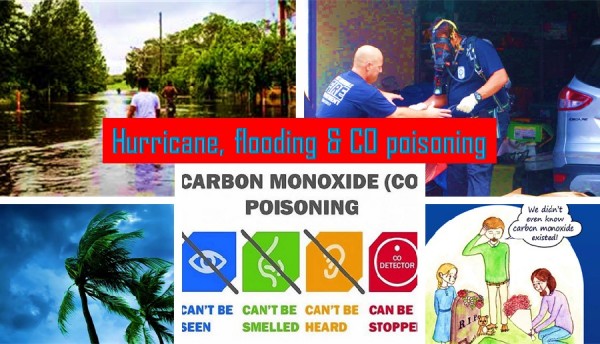
Hurricane, Flooding, carbon monoxide poisoning
This year many parts of the World are hit by hurricane, heavy rain and flooding. Just this month Hurricane Florence began affecting Southeastern US. Thousands of people are without electricity and water. Without power people look for alternate power sources such as gasoline generators, propane or charcoal grills. These sources are good but, If used improperly can lead to Carbon monoxide CO build up inside house, garage, buildings and can poison people, pet and other animals.
Carbon monoxide (CO), an odorless, colorless gas, which can cause sudden illness and death, is produced any time a fossil fuel is burned. Exposure to CO results in severe health symptoms. Mitigating and identifying CO source is critical in preventing CO poison.
Sources of Carbon monoxide
Gas water heaters, kerosene stove, charcoal grill, propane stove and heaters, petrol and diesel-powered generators, cigarette, forklifts with propane tank, boats, pain removers, solvents etc.
Symptoms of Carbon monoxide poisoning
- Headache
- Nausea
- Dizziness
- Eye burning
- Flu like symptom
- Fatigue and chest pain
- Impaired judgment,
- Confusion
- Blurry eyes
- Dryness in the mouth
- Vomiting, drowsiness
- Hallucination
- Depression and agitation
- Seizure and fainting
- Cough
- Shortness of breath, hoarseness and heavy/noisy breathing
Who are at high risk
- Elderly
- Pregnant women
- Babies and infants
- People with chronic diseases and respiratory problems.
Diagnosis:
- Blood test is the effective way to make CO poisoning in the system.
- Neurological exam can be part of evaluation.
- CO-oximeter helps to analyze the blood
- Fingertip pulso CO-oximeter is recommended to measure heart rate and oxygen saturation and COHgb (carboxyhemoglobin) levels in patients’ body.
- Brian computed tomography or MRI helps to show signs of cerebral infarction.
Precautions:
- If you or someone you know have any of the above symptoms in the affected areas, contact hospital and emergency department. Take your pets to Vet office.
- Move family members and pets to fresh air.
- Remove sources of CO -If you cannot – contact local fire department or public utility company.
- There are no home therapy available and seek medical help as soon as possible.
- If your area is expected to face situations where CO poisoning might be a threat – be ready with facial mask.
- Using facemask attached to an oxygen reserve bag (like one in the flights) could help
- In hospitals health care person might check your blood periodically for CO level. Hyperbaric pressure chamber may be used to provide higher oxygen in extreme cases.
You Can Prevent Carbon Monoxide Exposure (https://www.cdc.gov/co)
- Do have your heating system, water heater and any other gas, oil, or coal burning appliances serviced by a qualified technician every year.
- Do install a battery-operated or battery back-up CO detector in your home and check or replace the battery when you change the time on your clocks each spring and fall. If the detector sounds leave your home immediately and call emergency phone number.
- Do seek prompt medical attention if you suspect CO poisoning and are feeling dizzy, light-headed, or nauseated.
- Don’t use a generator, charcoal grill, camp stove, or other gasoline or charcoal-burning device inside your home, basement, or garage or near a window.
- Don’t run a car or truck inside a garage attached to your house, even if you leave the door open.
- Don’t burn anything in a stove or fireplace that isn’t vented.
- Don’t heat your house with a gas oven.
- Don’t use a generator, pressure washer, or any gasoline-powered engine less than 20 feet from any window, door, or vent.
For more information on carbon monoxide poisoning please visit
- https://www.cdc.gov/co
- https://www.emedicinehealth.com
Author: Sumana Rao | Posted on: September 17, 2018
« Understanding PLU Code Customized Viruses stimulate the Immune system to fight Cancer »






















Write a comment